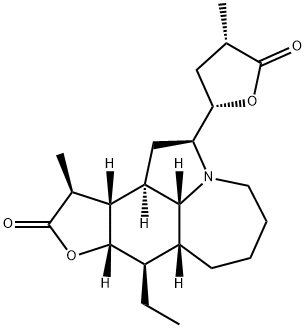tuberostemonine

|
- ₹0
- Product name: tuberostemonine
- CAS: 6879-01-2
- MF: C22H33NO4
- MW: 375.5
- EINECS:
- MDL Number:MFCD11111456
- Synonyms:tuberostemonine;(7aR,8aβ,11aβ,11bα,11cβ)-2β-[(2S,4S)-Tetrahydro-4-methyl-5-oxofuran-2-yl]-8β-ethyltetradecahydro-11β-methylfuro[2,3-h]pyrrolo[3,2,1-jk][1]benzoazepine-10-one;2β-[(2S,4S)-Tetrahydro-4-methyl-5-oxofuran-2-yl]stenine;Nsc366235;TUBERSTEMONINE(P);TuberosteMonin;Tuberostemonine, 98%, from Stemona tuberosa L.;Parathymine
| Manufacturer | Product number | Product description | Packaging | Price | Updated | Buy |
|---|
Properties
Melting point :86~88℃
Boiling point :554.2±50.0 °C(Predicted)
Density :1.19±0.1 g/cm3(Predicted)
storage temp. :2-8°C(protect from light)
solubility :DMF:10.0(Max Conc. mg/mL);26.63(Max Conc. mM)
DMF:PBS (pH 7.2) (1:2):0.33(Max Conc. mg/mL);0.88(Max Conc. mM)
DMSO:1.0(Max Conc. mg/mL);2.66(Max Conc. mM) form :A solid
pka :8.90±0.70(Predicted)
color :White to off-white
Boiling point :554.2±50.0 °C(Predicted)
Density :1.19±0.1 g/cm3(Predicted)
storage temp. :2-8°C(protect from light)
solubility :DMF:10.0(Max Conc. mg/mL);26.63(Max Conc. mM)
DMF:PBS (pH 7.2) (1:2):0.33(Max Conc. mg/mL);0.88(Max Conc. mM)
DMSO:1.0(Max Conc. mg/mL);2.66(Max Conc. mM) form :A solid
pka :8.90±0.70(Predicted)
color :White to off-white
Safety Information
| Symbol(GHS): |

|
||||||||||||||||||||||||||||||
|---|---|---|---|---|---|---|---|---|---|---|---|---|---|---|---|---|---|---|---|---|---|---|---|---|---|---|---|---|---|---|---|
| Signal word: | Warning | ||||||||||||||||||||||||||||||
| Hazard statements: |
|
||||||||||||||||||||||||||||||
| Precautionary statements: |
|
Description
This novel alkaloid has been isolated from Sternona sessilifolia and S. tuberosa and was first given the formula C19H29O4N, subsequently altered to that given above. It crystallizes in colourless needles from MeOH with 1 mole of solvent, m.p. 65-88°C (dec.) and has [α]D - 25.4° (Me2CO). It is a non-phenolic, tertiary base and yields a hydrobromide, m.p. 120°C (dec.) and a perchlorate, m.p. 242°C (dec.). The methiodide monohydrate has m.p. 236-8°C (dec.) and the methochloride, dihydrate, m.p. 172°C. A methosulphate has also been prepared, m.p. 253°C (dec.). The base is not hydrolyzed by acids but in the presence of excess PtO2 it gives the dihydro derivative, m.p. 133°C, furnishing a hydrochloride, m.p. 281 ° C. Oxidation with KMnO4 gives a C17 compound, whereas oxidation with silver oxide forms a neutral substance, C22H29O4N, m.p. 178°C which still contains the lactone groups and gives a positive Ehrlich pyrrole reaction.More related product prices
HEXABROMOBENZENE (-)-Huperzine A CASTICIN BAVACHIN Curcumol Mangostin Bilobalide Oridonin Praeruptorin A Peimine Tetradecanedioic acidRelated product price
- HEXABROMOBENZENE
₹1425-11600 - (-)-Huperzine A
₹2600-21444.33 - CASTICIN
₹19355.1-58086.95






